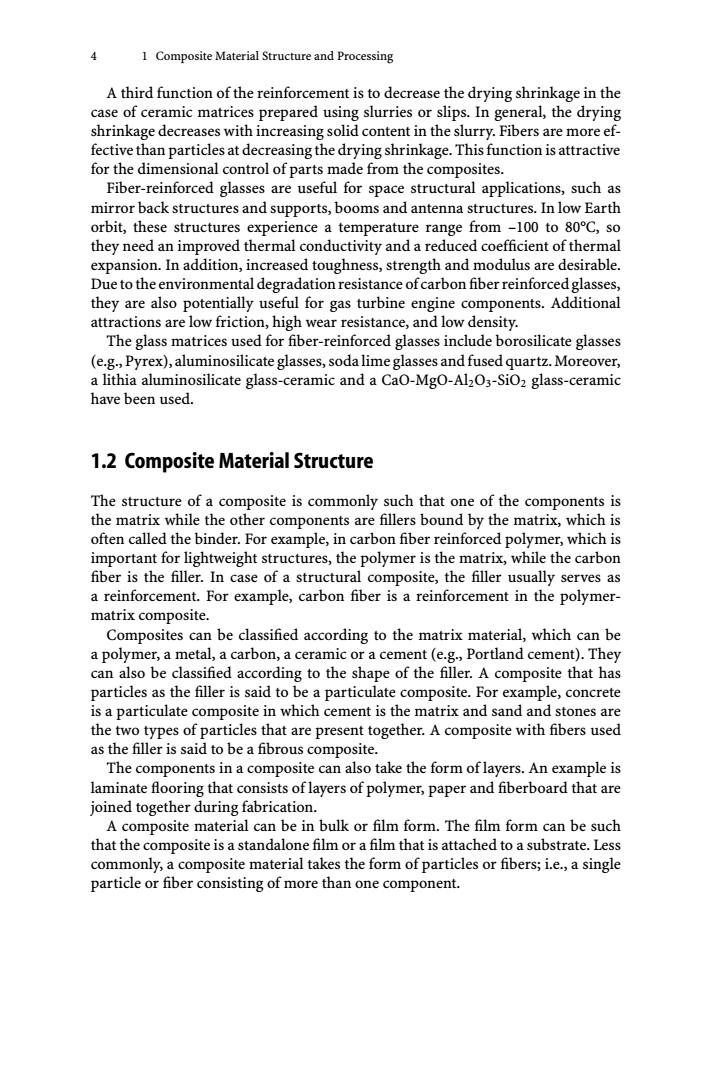正在加载图片...

4 1 Composite Material Structure and Processing A third function of the reinforcement is to decrease the drying shrinkage in the case of ceramic matrices prepared using slurries or slips.In general,the drying shrinkage decreases with increasing solid content in the slurry.Fibers are more ef- fective than particles at decreasing the drying shrinkage.This function is attractive for the dimensional control of parts made from the composites. Fiber-reinforced glasses are useful for space structural applications,such as mirror back structures and supports,booms and antenna structures.In low Earth orbit,these structures experience a temperature range from -100 to 80C,so they need an improved thermal conductivity and a reduced coefficient of thermal expansion.In addition,increased toughness,strength and modulus are desirable. Due to the environmental degradation resistance of carbon fiber reinforced glasses, they are also potentially useful for gas turbine engine components.Additional attractions are low friction,high wear resistance,and low density. The glass matrices used for fiber-reinforced glasses include borosilicate glasses (e.g.,Pyrex),aluminosilicate glasses,soda lime glasses and fused quartz.Moreover, a lithia aluminosilicate glass-ceramic and a CaO-MgO-Al2O3-SiO2 glass-ceramic have been used. 1.2 Composite Material Structure The structure of a composite is commonly such that one of the components is the matrix while the other components are fillers bound by the matrix,which is often called the binder.For example,in carbon fiber reinforced polymer,which is important for lightweight structures,the polymer is the matrix,while the carbon fiber is the filler.In case of a structural composite,the filler usually serves as a reinforcement.For example,carbon fiber is a reinforcement in the polymer- matrix composite. Composites can be classified according to the matrix material,which can be a polymer,a metal,a carbon,a ceramic or a cement (e.g.,Portland cement).They can also be classified according to the shape of the filler.A composite that has particles as the filler is said to be a particulate composite.For example,concrete is a particulate composite in which cement is the matrix and sand and stones are the two types of particles that are present together.A composite with fibers used as the filler is said to be a fibrous composite. The components in a composite can also take the form of layers.An example is laminate flooring that consists of layers of polymer,paper and fiberboard that are joined together during fabrication. A composite material can be in bulk or film form.The film form can be such that the composite is a standalone film or a film that is attached to a substrate.Less commonly,a composite material takes the form of particles or fibers;i.e.,a single particle or fiber consisting of more than one component.4 1 Composite Material Structure and Processing A third function of the reinforcement is to decrease the drying shrinkage in the case of ceramic matrices prepared using slurries or slips. In general, the drying shrinkage decreases with increasing solid content in the slurry. Fibers are more effective than particles at decreasing the drying shrinkage. This function is attractive for the dimensional control of parts made from the composites. Fiber-reinforced glasses are useful for space structural applications, such as mirror back structures and supports, booms and antenna structures. In low Earth orbit, these structures experience a temperature range from –100 to 80°C, so they need an improved thermal conductivity and a reduced coefficient of thermal expansion. In addition, increased toughness, strength and modulus are desirable. Due to the environmental degradation resistance of carbon fiber reinforced glasses, they are also potentially useful for gas turbine engine components. Additional attractions are low friction, high wear resistance, and low density. The glass matrices used for fiber-reinforced glasses include borosilicate glasses (e.g., Pyrex), aluminosilicate glasses, soda lime glasses and fused quartz. Moreover, a lithia aluminosilicate glass-ceramic and a CaO-MgO-Al2O3-SiO2 glass-ceramic have been used. 1.2 Composite Material Structure The structure of a composite is commonly such that one of the components is the matrix while the other components are fillers bound by the matrix, which is often called the binder. For example, in carbon fiber reinforced polymer, which is important for lightweight structures, the polymer is the matrix, while the carbon fiber is the filler. In case of a structural composite, the filler usually serves as a reinforcement. For example, carbon fiber is a reinforcement in the polymermatrix composite. Composites can be classified according to the matrix material, which can be a polymer, a metal, a carbon, a ceramic or a cement (e.g., Portland cement). They can also be classified according to the shape of the filler. A composite that has particles as the filler is said to be a particulate composite. For example, concrete is a particulate composite in which cement is the matrix and sand and stones are the two types of particles that are present together. A composite with fibers used as the filler is said to be a fibrous composite. The components in a composite can also take the form of layers. An example is laminate flooring that consists of layers of polymer, paper and fiberboard that are joined together during fabrication. A composite material can be in bulk or film form. The film form can be such that the composite is a standalone film or a film that is attached to a substrate. Less commonly, a composite material takes the form of particles or fibers; i.e., a single particle or fiber consisting of more than one component